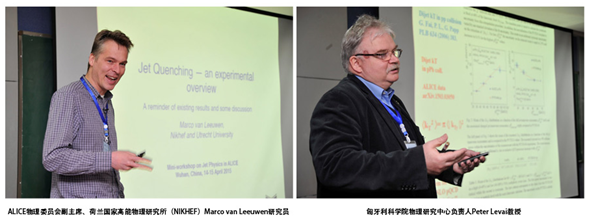From April 14th to April 15th, the LHC ALICE RUN-II International Symposium on Injection and Associated Physics was held in the Institute of Particle Physics, China, France, Germany, Italy, Japan, Hungary, Mexico and Switzerland. More than 30 domestic and foreign experts, scholars, postdoctoral and doctoral graduate students from each country participated in the seminar. European Union Research Center (CERN) LHC Large-scale Hadron Collider at the ALICE International Cooperation Group Spokesperson, French National Research Center (CNRS) Yves Schutz Fellow, Chairman of the ALICE International Cooperation Group Physics Committee, Federico Antinori, Italy INFN Padova Institute Researcher, Deputy Chairman of the ALICE Physical Committee, Researcher Marco van Leeuwen of the National Institute of High Energy Physics (NIKHEF), Netherlands; Professor Peter Levai, Head of the Physics Research Center of the Hungarian Academy of Sciences; Researcher Andreas Morsch, Head of CERN Team, ALICE Cooperation Committee, European Nuclear Research Center, ALICE Note Dr. Oliver Busch, Physician Group Coordinator, and Gustavo Conesa Balbastre, Coordinator of the Photon Physics Group, attended the meeting and invited the report. Professor Liu Feng, Executive Deputy Director of the Institute of Particle Physics at our university, made an opening statement. Professor Zhou Daicui, the coordinator of the ALICE China team and the deputy director of the Key Laboratory of Quark and Lepnophysics of our school, reported the progress of the Chinese group at the meeting. , RUN-II physics research plan and China's participation in the ALICE experiment upgrade idea.
The ALICE experiment is the only international collaborative experiment on the LHC at the large-scale heavy ion collider that is dedicated to the detection of a new material form, the quark gluon plasma (QGP). The goal is to fully and accurately measure the quark matter signal to reveal the nature of the quark matter. . The ALICE Cooperation Team is one of the largest international cooperation organizations in scientific cooperation research in this field so far. It has more than 1550 scientific and technical researchers from 38 countries. The ALICE experiment employs a large number of the most advanced particle detection, data processing and grid computing technologies in the world today. It is regarded as the 21st century's optimal experimental platform for studying extreme high-energy heavy ion collision physics. The ALICE experiment has used the experimental data of the first round of the LHC (RUN-I, 2010-2013) since 2010 to discover a series of new physical phenomena. After nearly two years of shutdown, the LHC accelerator beam stream was upgraded, and the detection device was updated with its readout system. In May of this year, the LHC will achieve 13 TeV proton-proton collisions and 5.02 TeV lead-lead collisions with beam brightness 10 times higher than RUN-I. The ALICE experiment will use a large statistical amount of experimental data in the second run of the LHC (RUN-II) to accurately measure the QGP signal and systematically study the properties of the QGP material.


作为ALICE实验的中方牵头单位,1999年以来,我校ALICE课题组在ALICE光子谱仪PHOS和双喷注电磁量能器EMCal/DCal及读出电子学研制上做出了突出贡献。2010年以来,在QGP硬探针信号和集体性质的物理分析上,取得了首批重要的物理成果。以我为主或联合开展物理分析,发表ALICE实验论文9篇,实验研究论文20余篇;代表ALICE合作组在国际会议上作报告20余次,主办ALICE实验相关的国际会议10余次。
本次会议汇集了喷注物理和关联物理方面国际前沿的实验和理论专家。与会专家学者充分交流和讨论了ALICE RUN-I物理分析现状,特别是对RUN-II实验数据分析战略和我校建议的RUN-II物理分析课题、研究方案和其可行性进行了深度讨论和充分论证。并就数据分析在ALICE分析组之间展开协调和建立亚洲区域性合作提出了宝贵的建设性建议。这次会议的顺利召开极大地推进了我校与ALICE合作组及其成员单位在该领域的实质性合作,进一步巩固了我校在超高能重离子碰撞物理研究领域的国际地位。